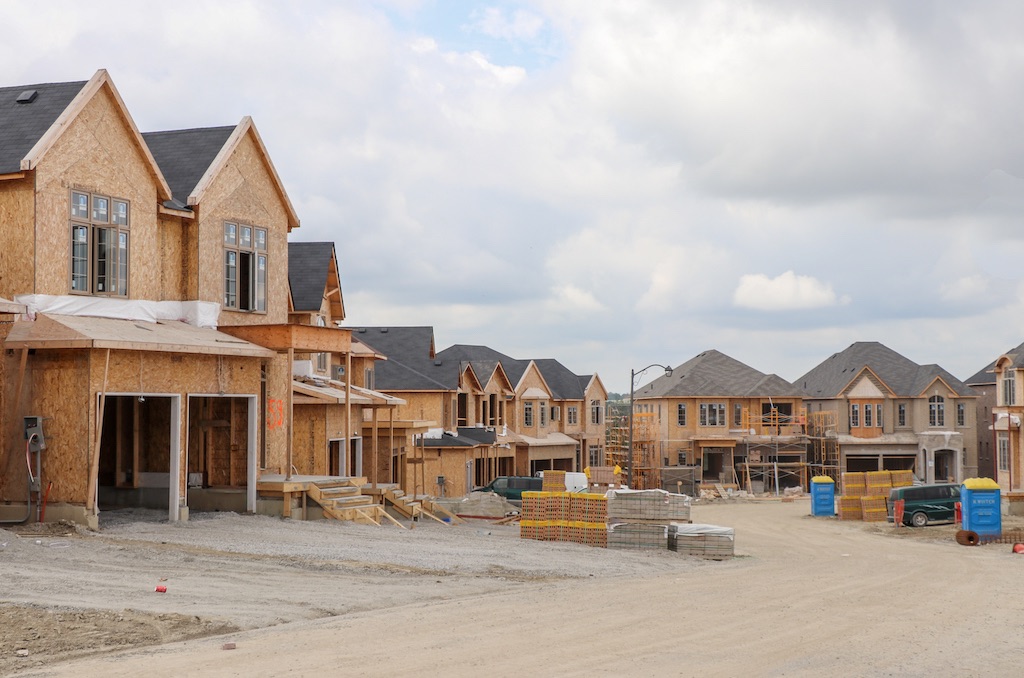Challenges Loom for Canadian Home Builders as Economic Headwinds Intensify
The Canadian home-building industry, traditionally a cornerstone of economic growth and stability, is currently facing a storm of challenges that threaten to cast a shadow over its once-optimistic outlook. As interest rates rise, the industry is grappling with a harsh reality—pinched capital expenditures and escalating carrying costs that are squeezing profit margins and causing a decline in project quantities.
Interest Rate Pressures: A Squeeze on Capital Expenditures
One of the primary challenges facing Canadian home builders is the persistent increase in interest rates. As central banks respond to economic conditions by tightening monetary policy, borrowing costs have been on the rise. This shift is impacting the ability of home builders to access affordable financing for new projects, expansions, and land acquisitions.
Higher interest rates translate into increased capital expenditures, which can have a cascading effect throughout the industry. Many home builders heavily rely on debt financing to fund their operations, and the higher cost of borrowing is now placing a significant strain on their financial resources. This, in turn, limits the scope for new projects and forces builders to reconsider the feasibility of ongoing developments.
Carrying Costs on the Rise: A Burden on Profit Margins
Carrying costs, including expenses related to land ownership, property taxes, and maintenance, are another area where home builders are feeling the pinch. With interest rates climbing, the carrying costs associated with holding onto undeveloped land or completed but unsold units are increasing. As projects face delays or struggle to find buyers in a more expensive borrowing environment, builders are forced to absorb these rising costs, further eroding profit margins.
The heightened carrying costs are not only a financial burden but also a strategic dilemma for home builders. As they grapple with the decision to hold onto properties in the hopes of improved market conditions or sell at potentially reduced prices, the delicate balance between risk and reward becomes increasingly challenging to navigate.
Dwindling Project Quantities: A Consequence of Economic Uncertainty
The combined impact of increased capital expenditures and rising carrying costs is leading to a tangible reduction in the quantity of projects undertaken by Canadian home builders. The cautious approach is a response to the economic uncertainty fueled by interest rate hikes and the broader economic landscape.
The decline in project quantities has a ripple effect on the entire construction ecosystem. Suppliers, contractors, and various other industry stakeholders are also impacted as the demand for construction materials and services dwindles. The interconnected nature of the construction industry means that a slowdown in home building can have far-reaching implications for the overall economy.
Navigating the Path Forward: Strategies for Resilience
In the face of these challenges, Canadian home builders must adopt strategies to weather the storm and position themselves for future success. Here are a few considerations:
- Diversification: Builders may explore diversifying their portfolios to include different types of projects or enter emerging markets that are less sensitive to interest rate fluctuations.
- Efficiency Improvements: Streamlining operations and improving efficiency can help offset some of the increased costs. Leveraging technology and innovative construction methods may lead to cost savings.
- Strategic Partnerships: Collaborating with strategic partners, including financial institutions, can help in navigating the changing economic landscape. Negotiating favorable financing terms and forming mutually beneficial partnerships can contribute to resilience.
- Market Research: Conducting thorough market research to identify areas with sustained demand and less sensitivity to interest rate changes can guide decision-making and project planning.
In conclusion, Canadian home builders are facing a challenging business environment marked by rising interest rates, increased carrying costs, and a reduction in project quantities. Navigating these headwinds will require strategic decision-making, adaptability, and a focus on long-term sustainability. While the current outlook may be pessimistic, the industry’s resilience and ability to innovate will play a crucial role in shaping its future trajectory.
Stocks that Are Vulnerable to A Housing Slowdown
- Canadian Home Builders:
- Examples: Brookfield Residential Properties Inc. (BRP), Mattamy Homes Limited
- Reasoning: Directly linked to the home building industry, these companies may face challenges such as reduced demand for new housing and declining property values.
- Building Materials Manufacturers – Canadian:
- Examples: Cascades Inc. (CAS), Canfor Corporation (CFP)
- Reasoning: A slowdown in home construction could lead to decreased demand for building materials, affecting the revenue of manufacturers.
- Real Estate Investment Trusts (REITs) – Canadian Residential:
- Examples: Canadian Apartment Properties REIT (CAR.UN), Killam Apartment REIT (KMP.UN)
- Reasoning: A decline in home building could impact the demand for rental properties, affecting the revenues and profitability of residential-focused REITs.
- Canadian Banks with Mortgage Exposure:
- Examples: Royal Bank of Canada (RBC), Toronto-Dominion Bank (TD)
- Reasoning: Banks with significant exposure to the mortgage market may face challenges if there’s a rise in mortgage delinquencies and a slowdown in lending activity.
- Canadian Home Improvement Retailers:
- Examples: RONA Inc., Home Hardware Stores Limited
- Reasoning: Reduced construction and home improvement activities could lead to lower demand for materials and supplies, impacting the revenue of Canadian home improvement retailers.
- Canadian Real Estate Developers:
- Examples: Brookfield Asset Management Inc. (BAM), First Capital Real Estate Investment Trust (FCR.UN)
- Reasoning: Real estate developers focusing on residential or mixed-use projects may experience challenges in selling properties or securing tenants during a downturn.
- Canadian Mortgage Insurance Companies:
- Examples: Genworth MI Canada Inc. (MIC), Canada Guaranty Mortgage Insurance Company
- Reasoning: A slowdown in the housing market could increase the risk of mortgage defaults, affecting mortgage insurers.
- Canadian Construction and Engineering Companies:
- Examples: Aecon Group Inc. (ARE), SNC-Lavalin Group Inc. (SNC)
- Reasoning: Construction companies involved in major infrastructure projects may face reduced contracts and lower revenues during a Canadian home builder downturn.
- Canadian Home Furnishing and Appliance Retailers:
- Examples: Leon’s Furniture Limited (LNF), The Brick Ltd.
- Reasoning: Lower home sales and construction activity can lead to decreased demand for home furnishings and appliances in the Canadian market.

STA Research (StockTargetAdvisor.com) is a independent Investment Research company that specializes in stock forecasting and analysis with integrated AI, based on our platform stocktargetadvisor.com, EST 2007.














































